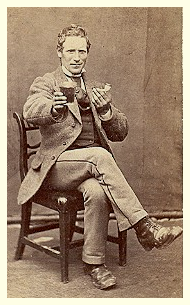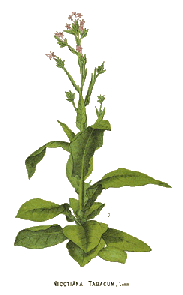
Huron Indian myth has it that in ancient times, when the land was barren and the people were starving, the Great Spirit sent forth a woman to save humanity. As she traveled over the world, everywhere her right hand touched the soil, there grew potatoes. And everywhere her left hand touched the soil, there grew corn. And when the world was rich and fertile, she sat down and rested. When she arose, there grew tobacco .


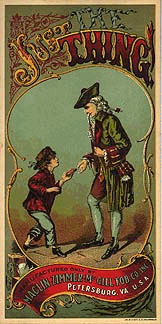
HOME | home
Iron on the Hearth | Iron, Cast and Forged | Cast Iron Cooking 4 | Copperware | Copper and Brassware 2 | Brass Alcohol Stove | Pipe Smoking | Tobacco the Indian Weed | Women's Pipes | Clay Pipe Collection | Pipes2 | pipes3 | Pipes4 | Pipe Tampers | Early Lighting 1 | Early Lighting 2 | Early Lighting 3 | Early Lighting 4 | Early Lighting 5 | Early Lighting 6 | My Lamps | Center Draft Lamps | Center Draft Lamps II | Center Drafts III | Miners lamps | Matches and Match Safes
Tobacco is But an Indian Weed
attr. to Thomas D'Urfey, c. 1719
Engraving after the French Huguenot painter Jacques Le Moyne de Morgues (c. 1533 to 1588)
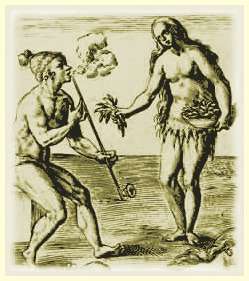
Tobacco's but an Indian weed,
Grows green in the morn, cut down at eve;
It shows our decay,
We are but clay;
Think of this when you smoke tobacco!
The pipe that is so lily white,
Wherein so many take delight,
It's broken with a touch,
Man's life is such;
Think of this when you take tobacco!
The pipe that is so foul within,
It shows man's soul is stained with sin;
It doth require
To be purred with fire;
Think of this when you smoke tobacco!
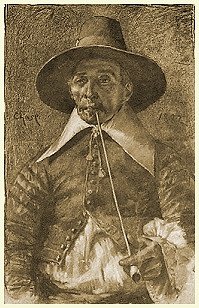
The dust that from the pipe doth fall,
It shows we are nothing but dust at all;
For we came from the dust,
And return we must;
Think of this when you smoke tobacco!
The ashes that are left behind,
Do serve to put us all in mind
That unto dust
Return we must;
Think of this when you take tobacco!
The smoke that does so high ascend,
Shows that man's life must have an end;
The vapour's gone,
Man's life is done;
Think of this when you take tobacco!
Based on the earlier poem, Smoking Spiritualized
Ancient Poems, Ballads and Songs of England

The origin and development of tobacco culture in colonial Virginia was a reflection of the growing British demand for leaf. In the early years of the colony, the settlers cultivated Nicotiana rustica, a variety of tobacco native to Virginia. It was inferior, however, to the milder Spanish type known as Nicotiana tabacum preferred by most Europeans.

Take a look at Cigar World for an
extensive selection in Cigars
and where you can find the best brands.
Native Americans used tobacco for both medicinal and ceremonial purposes. They used to inhale its smoke from burning leaf through the nostrils by means of a hollow forked cane and the name of the instrument was given to the plant which came to be known as `Tobaco' in Spanish and `Tobacco' in English. The plant was first introduced into Europe in the year 1560 by a Spanish physician sent to Mexico. About this time Jean Nicot, the French Ambassador to Portugal came to know of tobacco in Lisbon and introduced it to the French Court. The botanical name of the plant Nicotiana and the word nicotine have been derived from his name.
The origins of the tobacco plant will probably never be known. It appears to have been cultivated by the aboriginal peoples of the Americas since the very beginning of time. We only know a small bit of its history even though five centuries of tobacco use by Europeans has passed. Five hundred years ago tobacco had never been seen, touched or even thought of by those outside the Americas. Tobacco is now grown in 120 countries throughout the world and there is not a single country where smoking is not part of everyday life. The history of tobacco is dramatic by any standards. It is especially fascinating considering that a single tobacco seed is all but invisible. Indeed, one million seeds would weigh barely three to four ounces.
During the 16th century, tobacco use spread throughout all of Europe. It arrived in France in 1556, in Portugal in 1558, in Spain in 1559, and in England in 1565. By 1571 it had spread to nearly all parts of Europe. Not only did its usage spread quickly but also it quickly came to be seen as a cure for many major illnesses. In 1595, Anthony Chute published Tobacco in which he argued that physicians were keeping tobacco’s use a secret because they feared it would put them out of business. By 1630, over a million and a half pounds of tobacco were being exported from Jamestown, VA every year.
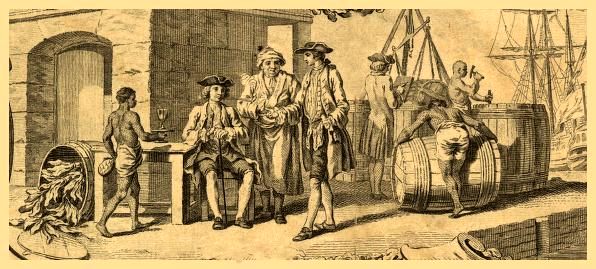
Although Tobacco reached Europe early in the age of exploration, the habit of smoking only spread in several countries during the 17th century. Many Europeans believed that smoking tobacco was not only a source of pleasure, but a cure for ills. The plant was clearly in high demand. To the colonists in America it therefore meant money.
Types of Pipe Tobacco
VIRGINIA: a sweet-tasting and light tobacco which forms a large part of the content of pipe tobacco in the USA and UK.
BURLEY: an air-cured tobacco, mild yet distinctive in flavour, which provides the base for many mixtures.
SUN CURED: a stronger tobacco with a very full flavour
FIRE CURED: the strongest of all full-strength tobaccos, though it provides an exceptionally cool smoking quality.
ORIENTAL: grown largely in the Balkans and eastern Mediterranean: and providing a distinctively aromatic smoke.
LATAKIA: again, a product of the eastern Mediterranean, and used in certain mixtures to give a distinctive flavour.
PERIQUE: grown largely around New Orleans, and subject to a curing process known to only one family, perique is used as a seasoner for other pipe tobaccos, providing a distinctive taste and aroma.
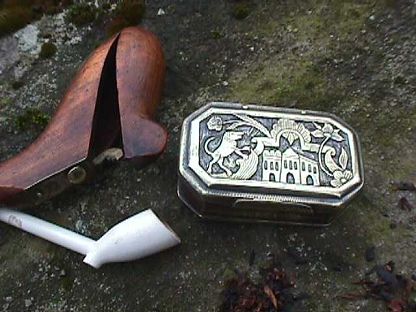
Tobacco was the original exotic commodity, becoming established in Europe well before drinks
such as tea and coffee and even before sugar and chocolate!

This song is an adaptation of Smoking Spiritualized. The earliest copy of the abridgment we have been able to meet with, is published in D'Urfey's Pills to Purge Melancholy, 1719; but whether we are indebted for it to the author of the original poem, or to 'that bright genius, Tom D'Urfey,' as Burns calls him, we are not able to determine. The song has always been popular.
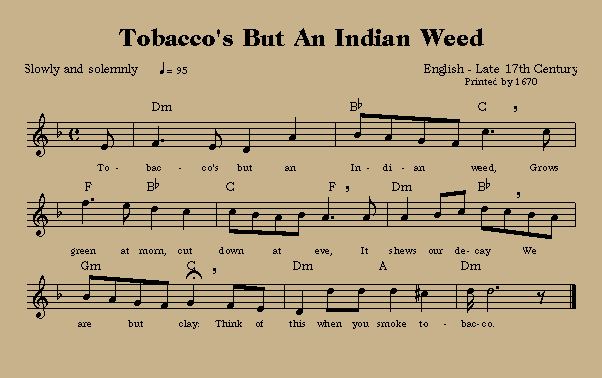

Vincente la Camera playing
Tobacco is But an Indian Weed
Learn more about pipes and tobacco by going to the
on Tobacco

E-Mail the Webmaster, Beth Maxwell Boyle

Smoke Pipes and don't inhale!
No part of this website may be used for any purpose ( including using images )
without written consent from The Rams Horn

